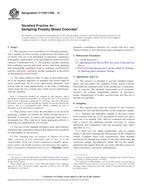Potřebujeme váš souhlas k využití jednotlivých dat, aby se vám mimo jiné mohly ukazovat informace týkající se vašich zájmů. Souhlas udělíte kliknutím na tlačítko „OK“.
ASTM C295/C295M-12
Standard Guide for Petrographic Examination of Aggregates for Concrete
Automaticky přeložený název:
Standardní Průvodce pro Petrografický agregátů pro beton
NORMA vydána dne 1.4.2012
Informace o normě:
Označení normy: ASTM C295/C295M-12
Poznámka: NEPLATNÁ
Datum vydání normy: 1.4.2012
Kód zboží: NS-12854
Počet stran: 9
Přibližná hmotnost: 27 g (0.06 liber)
Země: Americká technická norma
Kategorie: Technické normy ASTM
Kategorie - podobné normy:
Anotace textu normy ASTM C295/C295M-12 :
Keywords:
aggregate, analysis, composition, crushed rock, crushed stone, examination, ledge rock, manufacture sand, natural sand, petrography, quarry, Microscopic examination--concrete, Natural sand, Petrographic analysis, Rock materials/properties/analysis, Aggregate, Composition analysis, Crushed rock/stone, Drilled concrete cores, Ledge rock, Manufactured sand, Sand, Sieve analysis--aggregate, ICS Number Code 91.100.30 (Concrete and concrete products)
Doplňující informace
| Significance and Use | ||||||||||||||||
|
Petrographic examinations are made for the following purposes: To determine the physical and chemical characteristics of the material that may be observed by petrographic methods and that have a bearing on the performance of the material in its intended use. To describe and classify the constituents of the sample, To determine the relative amounts of the constituents of the sample that are essential for proper evaluation of the sample when the constituents differ significantly in properties that have a bearing on the performance of the material in its intended use, and To compare samples of aggregate from new sources with samples of aggregate from one or more sources, for which test data or performance records are available. This guide may be used by a petrographer employed directly by those for whom the examination is made. The employer should tell the petrographer, in as much detail as necessary, the purposes and objectives of the examination, the kind of information needed, and the extent of examination desired. Pertinent background information, including results of prior testing, should be made available. The petrographer's advice and judgment should be sought regarding the extent of the examination. This guide may form the basis for establishing arrangements between a purchaser of consulting petrographic service and the petrographer. In such a case, the purchaser and the consultant should together determine the kind, extent, and objectives of the examination and analyses to be made, and should record their agreement in writing. The agreement may stipulate specific determinations to be made, observations to be reported, funds to be obligated, or a combination of these or other conditions. Petrographic examination of aggregate considered for use in hydraulic-cement concrete is one aspect of the evaluation of aggregate, but petrographic examination is also used for many other purposes. Petrographic examinations provide identification of types and varieties of rocks present in potential aggregates. However, as noted above, identification of every rock and mineral present in an aggregate source is not required. The petrographic examination should establish whether the aggregate contains chemically unstable minerals such as soluble sulfates, unstable sulfides that may form sulfuric acid or create distress in concrete exposed to high temperatures during service, or volumetrically unstable materials such as smectites (formerly known as the montmorillonite-saponite group of minerals or swelling clays). Specifications may limit the quartz content of aggregates for use in concrete that may be subject to high temperature (purposefully or accidentally) because of the conversion to beta-quartz at 573 °C [1063 °F], with accompanying volume increase. Petrographic examination should identify the portion of each coarse aggregate that is composed of weathered or otherwise altered particles and the extent of that weathering or alteration, whether it is severe, moderate, or slight, and should determine the proportion of each rock type in each condition. If the concrete in which the aggregate may be used will be exposed to freezing and thawing in a critically saturated condition, finely porous and highly weathered or otherwise altered rocks should be identified because they will be especially susceptible to damage by freezing and thawing and will cause the aggregate portion of the concrete to fail in freezing and thawing. This will ultimately destroy the concrete because such aggregates cannot be protected by adequately air-entrained mortar. Finely porous aggregates near the concrete surface are also likely to form popouts, which are blemishes on pavements and walls. Petrographic examinations may also be used to determine the proportions of cubic, spherical, ellipsoidal, pyramidal, tabular, flat, and elongated particles in an aggregate sample or samples. Flat, elongated, and thin chip-like particles in aggregate increase the mixing water requirement and hence decrease concrete strength. Petrographic examination should identify and call attention to potentially alkali-silica reactive and alkali-carbonate reactive constituents, determine such constituents quantitatively, and recommend additional tests to confirm or refute the presence in significant amounts of aggregate constituents capable of alkali reaction in concrete. See Specification C33. Alkali-silica reactive constituents found in aggregates include: opal, chalcedony, cristobalite, tridymite, highly strained quartz, microcrystalline quartz, volcanic glass, and synthetic siliceous glass. Aggregate materials containing these constituents include: glassy to cryptocrystalline intermediate to acidic volcanic rocks, some argillites, phyllites, graywacke, gneiss, schist, gneissic granite, vein quartz, quartzite, sandstone, and chert. Criteria are available for identifying the minerals in the list above by their optical properties or by XRD (2),(3). Criteria are available for identifying rocks by their mineral composition and texture (4). Examination in both reflected and transmitted light may be necessary to provide data for these identifications. X-ray microanalysis using energy-dispersive x-ray spectrometers with scanning electron microscopy (SEM/EDX) or wavelength-dispersive x-ray spectrometers in electron microprobes (EMPA/WDX) may provide useful information on the chemical composition of minerals and rocks. Potentially deleterious alkali-carbonate reactive rocks are usually calcareous dolomites or dolomitic limestones with clayey insoluble residues. Some dolomites essentially free of clay and some very fine-grained limestones free of clay and with minor insoluble residue, mostly quartz, are also capable of some alkali-carbonate reactions, however, such reactions are not necessarily deleterious. Petrographic examination may be directed specifically at the possible presence of contaminants in aggregates, such as synthetic glass, cinders, clinker, or coal ash, magnesium oxide, calcium oxide, or both, gypsum, soil, hydrocarbons, chemicals that may affect the setting behavior of concrete or the properties of the aggregate, animal excrement, plants or rotten vegetation, and any other contaminant that may prove undesirable in concrete. These objectives, for which this guide was prepared, will have been attained if those involved with the evaluation of aggregate materials for use in concrete construction have reasonable assurance that the petrographic examination results wherever and whenever obtained may confidently be compared. |
||||||||||||||||
| 1. Scope | ||||||||||||||||
|
1.1 This guide outlines procedures for the petrographic examination of samples representative of materials proposed for use as aggregates in cementitious mixtures or as raw materials for use in production of such aggregates. This guide is based on Ref (1). 1.2 This guide outlines the extent to which petrographic techniques should be used, the selection of properties that should be looked for, and the manner in which such techniques may be employed in the examination of samples of aggregates for concrete. 1.3 The rock and mineral names given in Descriptive Nomenclature C294 should be used, insofar as they are appropriate, in reports prepared in accordance with this guide. 1.4 The values stated in either SI units or inch-pound units are to be regarded separately as standard. The values stated in each system may not be exact equivalents; therefore, each system shall be used independently of the other. Combining values from the two systems may result in non-conformance with the standard. 1.5 This standard does not purport to address all of the safety concerns, if any, associated with its use. It is the responsibility of the user of this standard to establish appropriate safety and health practices and determine the applicability of regulatory limitations prior to use. |
||||||||||||||||
| 2. Referenced Documents | ||||||||||||||||
|
Podobné normy:
Historická
1.4.2014
Historická
1.8.2011
Historická
1.2.2014
Historická
1.10.2010
Historická
1.1.2014
Historická
1.1.2013



 ASTM C1712-14
ASTM C1712-14 ASTM C1719-11
ASTM C1719-11 ASTM C172/C172M-14..
ASTM C172/C172M-14.. ASTM C1723-10
ASTM C1723-10 ASTM C173/C173M-14..
ASTM C173/C173M-14.. ASTM C1731-13
ASTM C1731-13
 Cookies
Cookies
